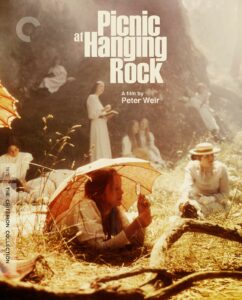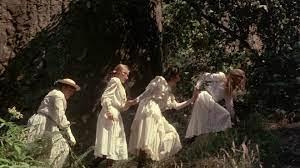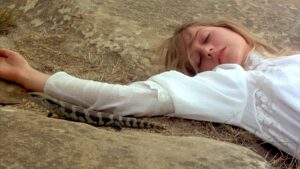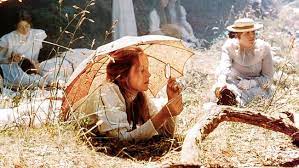“Picnic at Hanging Rock” – the Power of Mystery

Title: “Picnic at Hanging Rock”
Release Date: 1975
Director: Peter Weir
Cast: Rachel Roberts, Vivean Gray, Jacki Weaver, Helen Morse, Anne Louise Lambert
Peter Weir’s “Picnic at Hanging Rock” is an exceptional film in every respect. The director has used all available means to touch the Mystery – man, his physical-spiritual construction and transcendence. It is also a picture eminently imbued with femininity, which appears as a primal force lying at the basis of being.
“Picnic at Hanging Rock”, produced in 1975, is based on the novel by Australian writer Joan Lindsay. The plot, contrary to the author’s claims, does not depict real events, or at least there is no mention of them in any available chronicles. The action takes place at the dawn of a new century – in 1901, when several girls from an Australian boarding school are supposed to have disappeared without a trace during an expedition to Hanging Rock. According to the writer, this mysterious case has never been explained and this is also the case in the film – the viewer does not get answers to any of the important questions: what happened on the hill? Why were the girls’ bodies never found? Why was the only survivor, Irma, left unharmed but missing her corset and underwear? Leaving the ending open-ended is, of course, deliberate. Peter Weir only touches upon the Mystery, signals its presence, increases the viewer’s curiosity, but does not explain anything. Instead, he offers an incredible wealth of symbols that are like individual pieces of an intricate puzzle.
The film is set in Victoria, Australia, on St. Valentine’s Day. Here we see a boarding school for ladies of good standing going for a picnic after breakfast at Hanging Rock, a local natural attraction. Three excited schoolgirls, Miranda, Irma, and Marion, want to explore the hill more closely and gain permission from the teachers to do so. Plump Edith also joins them. Remarkably, she is the only one who does not succumb to the charms of Hanging Hill.

As the girls get more and more excited about their trip and climb higher and higher, Edith grows restless. Finally, the girl screams her way back down, passing one of her chaperones, Miss McCraw, a math teacher, on the way. The woman, in just her underwear, proceeds to the top. In the evening it turns out that none of the participants of the expedition returns, and the local police undertake a fruitless search. After a week, Michael, a wealthy gentleman who witnessed the girls’ journey up the hill, miraculously finds Irma.
“Picnic at Hanging Rock” – nature and culture
The most important meanings in “Picnic at Hanging Rock” are situated within the opposition of nature and culture. The latter seems clearly oppressive; it is marked by the space of the girls’ boarding school with its rigid curriculum and boring memorization. The symbols of cultural bonds are corsets and gloves, which must be worn by girls from good homes. For this reason, the permission given by the owner of the school to girls going on a picnic to take off their gloves has a special meaning. The behavior of the boarding school girls climbing the rock is also significant: they take off their shoes and stockings, and Irma, who is found later, is not wearing a corset. Also, the stable teacher, Miss McCraw, captivated by the magnetism of the place, gets rid of her elaborate dress.
Nature in “Picnic at Hanging Rock” is not the simple opposite of culture. Its most important symbol, Mount Diogenes, acquires an almost metaphysical meaning. This rock is a space of transcendence, and as such, it has an ambivalent face. On the one hand, it bewitches girls, liberates them from social conventions, and allows them to discover the essence of being. On the other hand, the hill evokes fear and leads the girls to their doom.

“Picnic at Hanging Rock” – science and art
The opposition of nature and culture in the film does not take the form of a bivalent alternative: good versus evil. Culture is not only oppression, but also art and science. These are, as it were, two languages through which man can express his experience. The representative of science is Miss McCraw, the science teacher. She explains to the girls the geological aspects of the hill. Her argument about the age of Mount Diogenes is extremely significant in this context. Namely, it is about a million years old, which, when put in perspective with the age of the Great Watershed Mountains chain, makes it a young uplift. It is also Miss McCraw who notes that her watch stopped at twelve o’clock during the picnic. What we have here, then, is a kind of philosophy of time which, as Einstein’s theory says, is relative. It can be a moment, but also eternity.
The other guardian of the residents, a French teacher, Miss Dianne de Poitiers, is an art lover. She is able to see the world through the eyes of the works of great masters. For example, she notices that the beautiful golden-haired Miranda, who becomes the guide of the expedition to the hill, resembles Venus from the famous painting by Botticelli. It is also worth noting that the cinematography in “Picnic at Hanging Rock” is clearly stylized on the paintings of the Impressionists and Pre-Raphaelites. An important role is played by the play of light and color. There is also a symbolic change of colors – from bright at the beginning of the film to dark at the end. It is impossible to overestimate the role of the incredible music, which gives rhythm to individual scenes. The romantic sound of Gheorghe Zamfir’s flute combined with the recording of an approaching earthquake gives the whole a unique aura.

“Picnic at Hanging Rock” – eroticism and convention
Another side of the juxtaposition of nature and culture in “Picnic at Hanging Rock” is the clash between physicality and Victorian morality. The girls’ climbing up the hill has clear erotic traits, it even has the traits of sexual initiation. The very time of the film’s action – St. Valentine’s Day – gives the whole film an amorous atmosphere. The women boarders are in a kind of trance and go through the successive stages of their journey as if they were lovers exposing themselves to their partner. The girls’ modest white dresses are a symbol of innocence, and the first sign of its loss is when the girls cross the stream. In this context, the change in Irma, who, having recovered, appears at the boarding house in a sumptuous red dress, becomes significant.
At the same time, sexual initiation in “Picnic at Hanging Rock” is tantamount to entering the sphere of metaphysics. Both are extremely dangerous, leading to loss or death. Erotic initiation always involves a kind of rite of passage. It constitutes an irrevocable destruction of the old order. The golden-haired Miranda is a particular object of love in the film. It is to her that sensitive Sara addresses her erotic poems. Michael also succumbs to Miranda’s charm and for her he undertakes a risky search.
It is worth noting that the female element dominates in the film. The director tries to fascinate the viewer with subsequent images of girls – their dresses, hats, flowing hair and misty eyes. Femininity is, in a way, originally connected with nature, guided by carnality and intuition. One can even find here echoes of Freudian theories of hysteria, especially considering the time of the action – the beginning of the century – when women suffered from neuroses. The final scene of Sara’s suicide is the quintessence of all these meanings, and “Picnic at Hanging Rock” becomes an intricately constructed whole which opalesces with a wealth of different meanings.
Literature:
A.Grabicz, “Kino, wehikuł magiczny. Przewodnik filmu fabularnego. Podróż piąta 1974 – 1981”, Kraków 2009.
